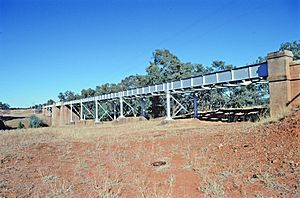Angellala Rail Bridge facts for kids
Quick facts for kids Angellala Rail Bridge |
|
|---|---|

Angellala Rail Bridge, 1994
|
|
| Location | Roma-Cunamulla railway over Angellala Creek in Sommariva, Shire of Murweh, Queensland, Australia |
| Design period | 1870s - 1890s (late 19th century) |
| Built | c. 1885 - 1994 |
| Architect | Henry Charles Stanley |
| Official name: Angellala Rail Bridge | |
| Type | state heritage (built) |
| Designated | 21 October 1992 |
| Reference no. | 600756 |
| Significant period | 1880s (fabric) |
| Significant components | abutments - railway bridge, pier/s (bridge) |
| Lua error in Module:Location_map at line 420: attempt to index field 'wikibase' (a nil value). | |
The Angellala Rail Bridge is a very old and important railway bridge. It is located on the Roma-Cunnamulla railway line in Sommariva, Queensland, Australia. This special bridge crosses Angellala Creek. It was designed by Henry Charles Stanley and built around 1885. The bridge is so important that it was added to the Queensland Heritage Register in 1992.
Contents
The Bridge's Story
Building the Western Railway
Plans for the Angellala Creek bridge were made in 1885. This was when the railway line was being extended from Roma to Charleville. The Queensland Government decided to build this railway line. It helped connect towns further west.
The railway opened in stages. It reached East Mitchell in 1883. Then it arrived in Mitchell in 1885. Later, it extended to Dulbydilla in 1885. It reached Morven in 1887. Finally, the railway line opened all the way to Charleville in 1888.
Angellala Railway Station
A railway station named Angellala opened near the creek in 1910. It was a place where trains could stop. From 1929 to 1932, the station was not staffed. But a station mistress worked there from 1932 until 1971. Angellala was also a watering stop for steam locomotives. This meant trains could refill their water tanks there.
Designing the Bridge
Building the bridge over Angellala Creek was tricky. The area was a shallow valley with a wide flood plain. This meant the bridge needed to be very long. The part of the bridge coming from the west is made of timber. It is the longest timber approach on any railway bridge in Queensland. This section is about 530 meters long. The main part of the bridge crossing the creek uses seven steel sections. The total length of the bridge is about 634 meters. Henry Charles Stanley, the Chief Engineer, designed it in 1885.
Upgrades Over Time
The bridge has been strengthened several times. In 1946, it was made stronger for heavier trains. This was done by adding more support columns. In 1994, more steel supports were added. This allowed even larger diesel-electric trains to use the line.
The Angellala bridge is the sixth longest railway bridge in Queensland. Its long timber approach is unique. The steel parts of the bridge are also very old. They are the second oldest of their kind in Queensland.
What the Bridge Looks Like
The Angellala Creek Bridge is located about 711 kilometers from Roma Street. It is a long structure with different parts.
- It has sections made of timber. These timber parts are supported by strong timber frames.
- The main part of the bridge has seven sections made of steel. These steel sections are very strong. They have special steel beams and supports.
- Many of the bridge's supports are made of concrete. Some older supports are made of cast iron.
- In 1994, extra steel supports were added. These new supports help the bridge carry heavier modern trains.
The bridge is built on a straight section of track. The parts leading up to the bridge are on a gentle curve. The very first parts of the bridge, like the ends and main supports, are original. However, some parts of the bridge's approaches have been rebuilt. The added supports in 1994 were important. They allowed large diesel-electric locomotives to travel between Roma and Charleville.
Why the Bridge is Important
The Angellala Rail Bridge was added to the Queensland Heritage Register in 1992. This means it is a very important historical site.
- It shows Queensland's history: The bridge helps us understand how Queensland's railway network grew. Especially how it reached the western parts of the state.
- It has rare features: The steel parts of the bridge are very old. They are the second oldest of their type in Queensland. This makes them quite special and uncommon.
- It looks good: The bridge is close to the Warrego Highway. It is a noticeable and important landmark. It stands out as you approach Angellala from the west.
- It's important to the community: Because it's a landmark, it's a familiar and important sight for people in the area.
- It's linked to a famous person: The bridge is important because of its designer, Henry C Stanley. He was a very important Chief Engineer for Railways in Queensland.

